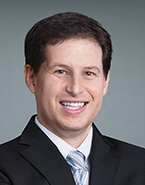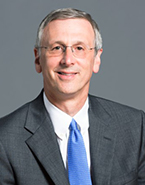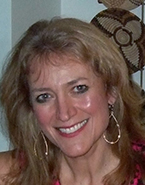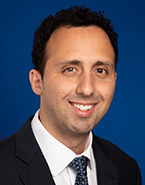Radiologists Answer the Call During COVID-19 Pandemic
Radiologists step into new roles helping patients, families and other physicians during crisis




Early in April, as the coronavirus pandemic was tightening its grip on New York City, area resident Katherine Padilla began noticing changes in her father David Santos. He had grown weak and was having trouble controlling his glucose levels.
“My dad never showed the signs of coronavirus that people would say to watch for,” she said. “No fever, no cough, no complaints of not being able to breathe. He didn’t want to go to the hospital because he didn’t want to get the virus.”
When Santos began needing help getting dressed and going down the steps of his apartment, his daughter took him to NYU Langone Health in New York City where, despite the atypical symptoms, he tested positive for COVID-19. He was admitted on April 15. Due to the risk of infection, his daughter couldn’t be with him in the hospital in the crucial days when his health hung in the balance.
Fortunately, she had a line of communication to the hospital through radiologist Myles Taffel, MD, associate section chief at NYU Langone. As a volunteer in NYU’s Family Connect program, Dr. Taffel called Padilla every day with updates on her father’s condition.
“He would explain the test results and what they meant,” she said. “I also appreciated having the ability to call the hospital at any time in case I had an urgent question regarding my dad. I would’ve never had the ability to do that at any hospital around my neighborhood.”
Padilla’s father made a steady recovery and was released from the hospital on May 2, just over two weeks after his admission.
“I will forever be grateful to NYU and their staff,” Padilla said. “Throughout this whole ordeal, the Family Connect program gave me ease and peace.”
Connecting Radiologists and Patients
The Family Connect program was the brainchild of Katherine Hochman, MD, a hospitalist at NYU Langone who saw an opportunity to tap into the experience of physicians whose work had slowed during the pandemic. Shortly after Dr. Hochman hatched the idea, she reached out to Michael P. Recht, MD, chair of radiology at NYU Langone, for help. Dr. Recht, in turn, tapped Dr. Taffel to take a leadership role in implementing the program.
“My internship was almost 15 years ago,” Dr. Taffel said. “I am not sure that I remember how to hold a stethoscope at this point in my career. Those of us not able to participate in direct ward care were looking for alternative ways to contribute. This was a great opportunity to help make a difference!”
The radiology department put out a call for volunteers and within what Dr. Taffel called “the blink of an eye,” 65 radiologists had signed on, along with dozens of medical students.
“We basically had about five days to get this up and running,” Dr. Taffel said. “We had to train all of our radiologists to find the critical information on patients, learn the different ways that oxygen was being administered, and get trained on what kind of information they were going to need to know for patient calls.”
After reviewing individual patient charts, the volunteers started each day by participating in virtual rounds with the medical teams directly caring for the patients. Each radiologist was responsible for seven or eight patients and calling their anxious family members with the latest information.
“At least a half-dozen times I was having that first conversation with a family member about the possibility that their loved one may not get better,” Dr. Taffel said. “It’s a tough spot to be in, but we had victories too where we saw people get better and walk out of the hospital.”
Besides the obvious benefits to patients’ families, the program has also given a sense of purpose to the radiologists at NYU Langone who saw imaging volume drop significantly as the pandemic spread.
“A lot of our radiologists were working remotely and weren’t able to see their teams,” Dr. Recht said. “It would have been so easy for them to become disengaged. I think the ability to be engaged with patients’ families, the ability to be part of the virtual rounds, it really gave them a chance to feel that they were part of the process.”
Helping Where Needed
Family Connect is just one example of how radiologists found ways to help out at hospitals stretched to their limits by the coronavirus pandemic. At Kaiser Permanente in Santa Clara, CA., radiologists staffed a phone center to answer questions about COVID-19 exposure. Some served as hospital ambassadors stationed at the building entrance to screen anyone who had symptoms and take routine requests for prescription refills or forms.
“A lot of this was unprecedented so we had to develop new measures to protect our staff and serve our patients,” said Mark Mamlouk, MD, neuroradiologist at Kaiser Permanente. “We adapted through teamwork, and I think that’s what has been the major success at our hospital and at every hospital in fighting COVID-19.”
Taking Lessons Back to Practice
For veteran radiologists like Reni S. Butler, MD, a breast imaging specialist at Yale New Haven Health in New Haven, CT, the time as a volunteer has been both challenging and fulfilling. Dr. Butler is one of five radiologists who’ve been keeping in touch with patients’ families through Yale’s version of Family Connect.
“I didn’t know how useful I would be, being away from clinical medicine as long as I have, but the experience has been very rewarding,” she said. “When you know that so many physicians are on the front lines, you really want to use your medical background to help. It can be challenging, but I have plenty of practice because I speak with patients on a daily basis about their breast health.”
The volunteer work by health care professionals, including radiology staff, has been one of the bright spots of the pandemic. And the lessons learned from COVID-19 are likely to pay off long after the pandemic abates.
“Patients have been so appreciative of what we do, and that’s been very gratifying to hear,” Dr. Mamlouk said. “This experience has been tough on everyone and we’re happy and honored to be able to serve in a role helping our patients.”
For More Information
Access RSNA's COVID-19 resources.